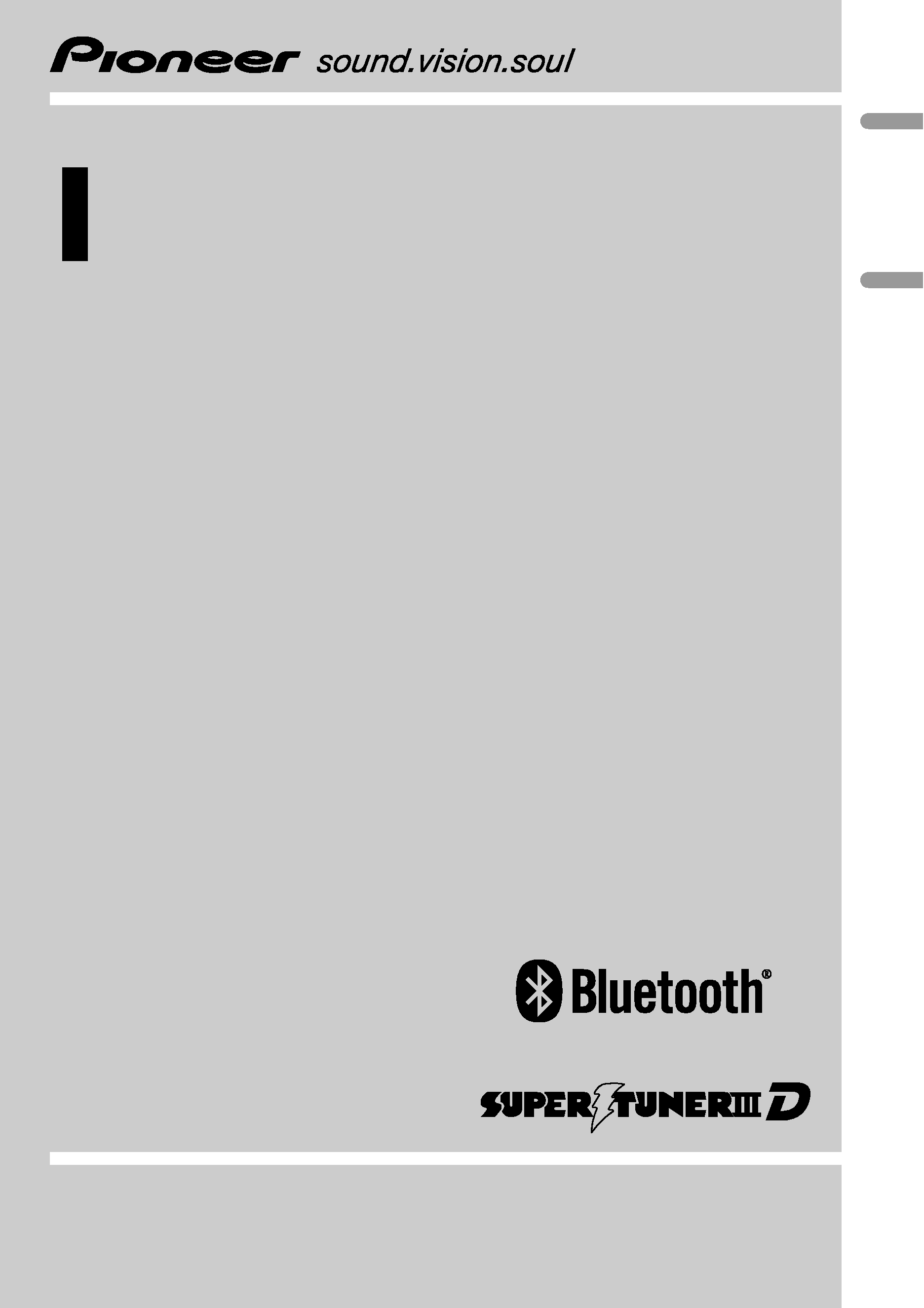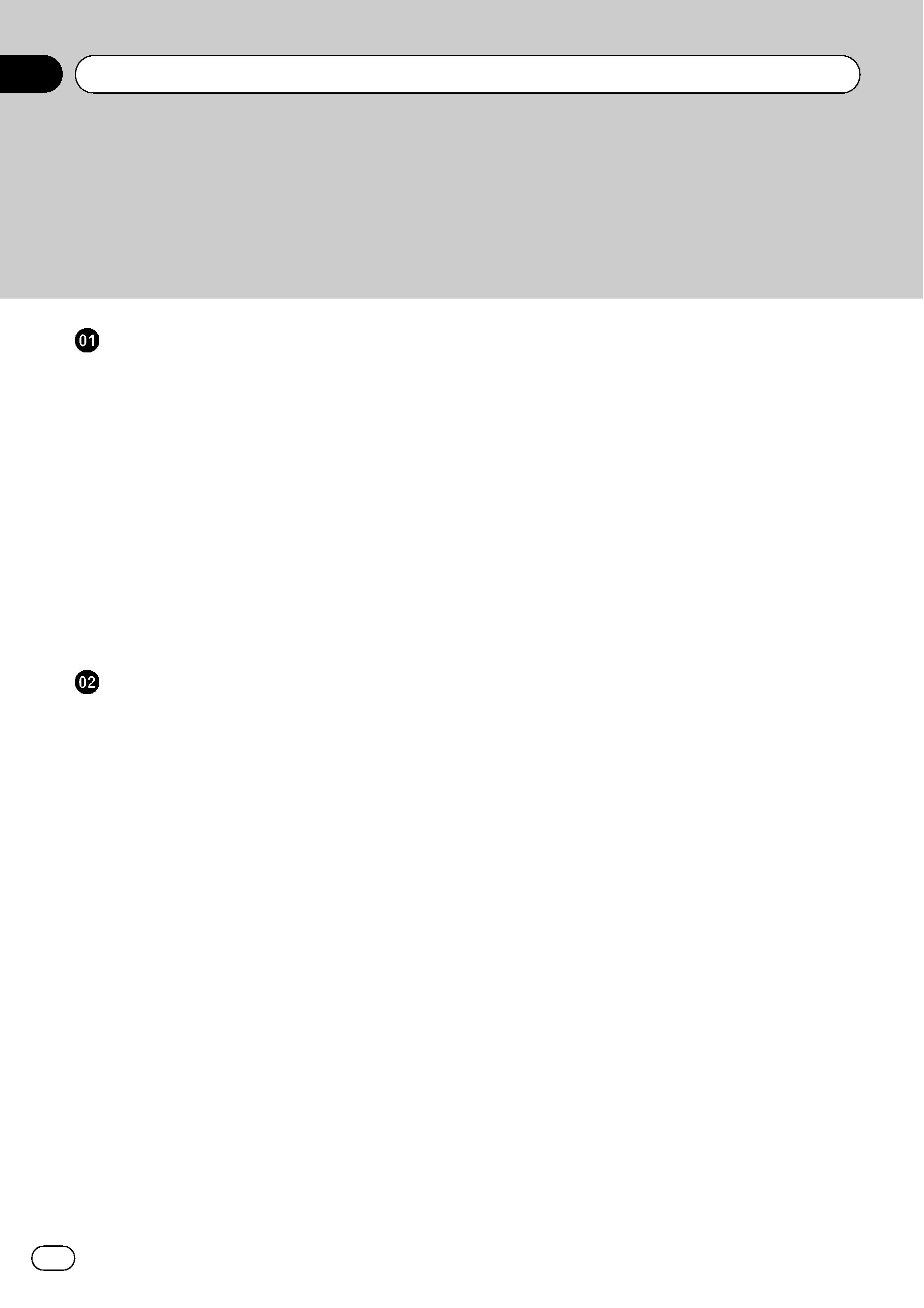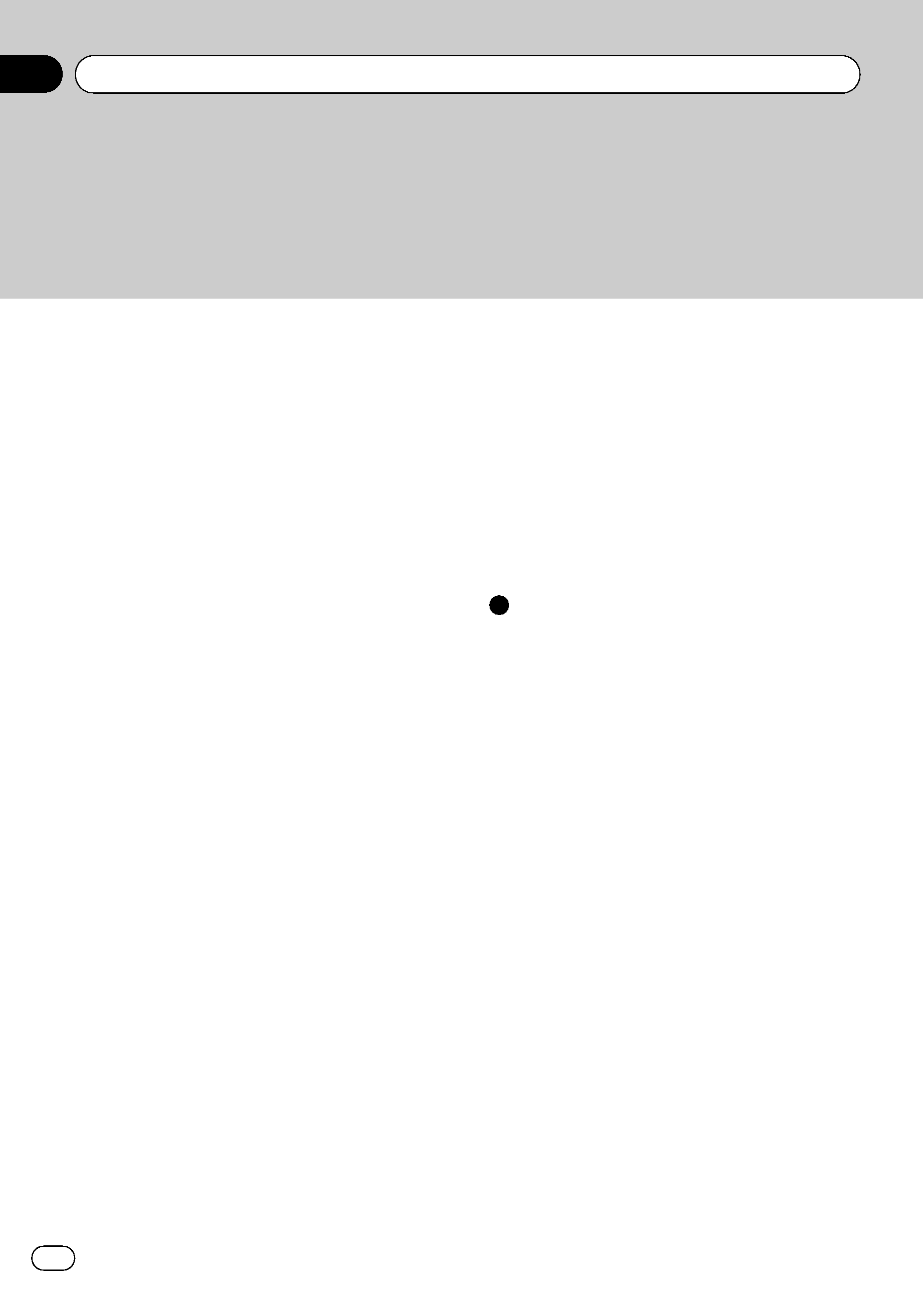
Operation Manual
Mode d
'emploi
CD Receiver
Récepteur CD
DEH-P7900BT
English
Français

Thank you for buying this Pioneer product.
Please read through these operating instructions so you will know how to operate
your model properly. After you have finished reading the instructions, keep this man-
ual in a safe place for future reference.
Before You Start
Information to User
5
For Canadian model
5
About this unit
5
After-sales service for Pioneer products
7
Visit our website
8
Protecting your unit from theft
8
Removing the front panel 8
Attaching the front panel 8
Resetting the microprocessor
9
About the demo mode
9
Use and care of the remote control
9
Installing the battery 9
Using the remote control 10
Operating this unit
What
's What 11
Head unit 11
Remote control 11
Basic Operations
12
Power ON/OFF 12
Selecting a source 12
Adjusting the volume 13
Tuner
13
Basic Operations 13
Storing and recalling broadcast
frequencies
14
Introduction of advanced
operations
14
Storing the strongest broadcast
frequencies
14
Tuning in strong signals 15
Built-in CD Player
15
Basic Operations 15
Selecting a track directly 16
Introduction of advanced
operations
17
Selecting a repeat play range 17
Playing tracks in random order 17
Scanning folders and tracks 18
Pausing disc playback 18
Using compression and BMX 18
Searching every 10 tracks in the current
disc or folder
18
Using disc title functions 18
Displaying text information on disc 19
Selecting tracks from the track title
list
19
Selecting tracks from the file name
list
20
Playing songs on iPod
20
Basic Operations 20
Browsing for a song 21
Displaying text information on
iPod
21
Introduction of advanced
operations
21
Repeating play 22
Playing songs in a random order
(shuffle)
22
Playing all songs in a random order
(shuffle all)
22
Pausing a song 22
Changing audiobook speed 22
Bluetooth Audio
23
Basic Operations 23
Setting up for Bluetooth audio
player
24
Introduction of advanced
operations
24
Connecting a Bluetooth audio
player
25
Disconnecting a Bluetooth audio
player
25
Connecting the most recently
connected Bluetooth audio player
25
Playing songs on Bluetooth audio
player
25
Contents
En
2

Stopping playback 25
Pausing a song 26
Connecting to a Bluetooth audio player
automatically
26
Displaying BD (Bluetooth Device)
address
26
Bluetooth Telephone
27
Basic Operations 27
About the telephone source 28
Setting up for hands-free phoning 28
Making a phone call 28
Taking a phone call 29
Introduction of advanced
operations
30
Connecting a cellular phone 31
Disconnecting a cellular phone 31
Registering connected cellular
phone
32
Deleting a registered phone 32
Connecting to a registered cellular
phone
32
Using the Phone Book 33
Using the Call History 37
Assigning preset numbers 38
Making a call by entering phone
number
38
Clearing memory 38
Setting the automatic rejecting 39
Setting the automatic answering 39
Changing the ring tone 39
Echo canceling and noise
reduction
39
Displaying BD (Bluetooth Device)
address
39
Selecting the incoming call screen 40
Audio Adjustments
40
Introduction of audio adjustments 40
Using balance adjustment 41
Using the equalizer 41
Adjusting loudness 42
Using subwoofer output 42
Boosting the bass 43
Using the high pass filter 43
Adjusting source levels 43
Initial Settings
44
Adjusting initial settings 44
Selecting the display language 45
Setting the date 45
Setting the clock 45
Switching the warning tone 45
Switching the face auto open 45
Switching the auxiliary setting 46
Switching the dimmer setting 46
Adjusting the brightness 46
Setting the rear output and subwoofer
controller
46
Switching the sound muting/
attenuation
46
Switching the feature demo 47
Switching the reverse mode 47
Switching the Ever Scroll 47
Activating the BT Audio source 47
Entering PIN code for Bluetooth
wireless connection
48
Editing device name 48
Displaying system version for
repair
48
Resetting the Bluetooth wireless
technology module
49
Other Functions
49
Using the AUX source 49
Turning the clock display on or off 50
Using different entertainment
displays
50
Using the PGM button 50
Available accessories
USB adapter
52
Basic Operations 52
En
3
English
Contents

Selecting an audio file directly in the
current folder
52
Introduction of advanced
operations
52
Displaying text information of an audio
file
53
Selecting files from the file name
list
53
XM tuner
54
Basic Operations 54
Selecting an XM channel directly 54
Switching the XM display 54
Storing and recalling broadcast
stations
54
Selecting a channel in the channel
category
55
Displaying the Radio ID 55
SIRIUS Satellite Radio tuner
56
Basic Operations 56
Selecting a SIRIUS channel
directly
56
Introduction of advanced
operations
56
Switching the SIRIUS display 57
Storing and recalling broadcast
stations
57
Selecting a channel in the channel
category
57
Using the Game Alert function 57
Displaying the Radio ID 58
Multi-CD Player
59
Basic Operations 59
Selecting a track directly 59
Introduction of advanced
operations
59
Using ITS playlists 60
Using disc title functions 61
Using CD TEXT functions 62
DVD Player
62
Basic Operations 62
Selecting a disc 63
Selecting a folder 63
Introduction of advanced
operations
63
TV tuner
64
Basic Operations 64
Storing and recalling broadcast
stations
65
Storing the strongest broadcast
stations sequentially
65
Additional Information
Troubleshooting
66
Understanding error messages
66
Handling guideline of discs and player
67
Dual Discs
67
Compressed audio files
67
Example of a hierarchy 68
Compressed audio compatibility 68
About handling the iPod
68
About iPod settings 69
Specifications
70
Contents
En
4

Information to User
FCC ID: AJDK014
MODEL NO.: DEH-P7900BT
IC: 775E-K014
This device complies with Part 15 of FCC Rules
and RSS-Gen of IC Rules. Operation is subject
to the following two conditions: (1) this device
may not cause interference, and (2) this device
must accept any interference, including inter-
ference that may cause undesired operation of
this device.
MADE IN THAILAND
This equipment has been tested and found to
comply with the limits for a class B digital de-
vice, pursuant to Part 15 of the FCC Rules.
These limits are designed to provide reason-
able protection against harmful interference in
a residential installation.
This equipment generates, uses and can radi-
ate radio frequency energy and, if not installed
and used in accordance with the instructions,
may cause harmful interference to radio com-
munications. However, there is no guarantee
that interference will not occur in a particular
installation.
If this equipment dose cause harmful interfer-
ence to radio or television reception, which
can be determined by turning the equipment
off and on, the user is encouraged to try to cor-
rect the interference by one or more of the fol-
lowing measures:
! Reorient or relocate the receiving antenna.
! Increase the separation between the equip-
ment and receiver.
! Connect the equipment into an outlet on a
circuit different from that to which the re-
ceiver is connected.
! Consult the dealer or an experienced radio/
TV technician for help.
Alteration or modifications carried out without
appropriate authorization may invalidate the
user
's right to operate the equipment.
! This transmitter must not be co-located or op-
erated in conjunction with any other antenna
or transmitter.
! This equipment complies with FCC/IC radia-
tion exposure limits set forth for uncontrolled
equipment and meets the FCC/IC radio fre-
quency (RF) Exposure Guidelines in Supple-
ment C to OET65 and RSS-102 of the IC radio
frequency (RF) exposure rules. This equipment
has very low levels of RF energy that it is
deemed to comply without testing of specific
absorption ratio (SAR).
For Canadian model
Operation is subject to the following two condi-
tions:
(1) This device may not cause harmful interfer-
ence, and (2) this device must accept any inter-
ference received, including interference that
may cause undesired operation.
This Class B digital apparatus complies with
Canadian ICES-003.
About this unit
The tuner frequencies on this unit are allo-
cated for use in North America. Use in other
areas may result in poor reception.
Before You Start
En
5
English
Section
01
